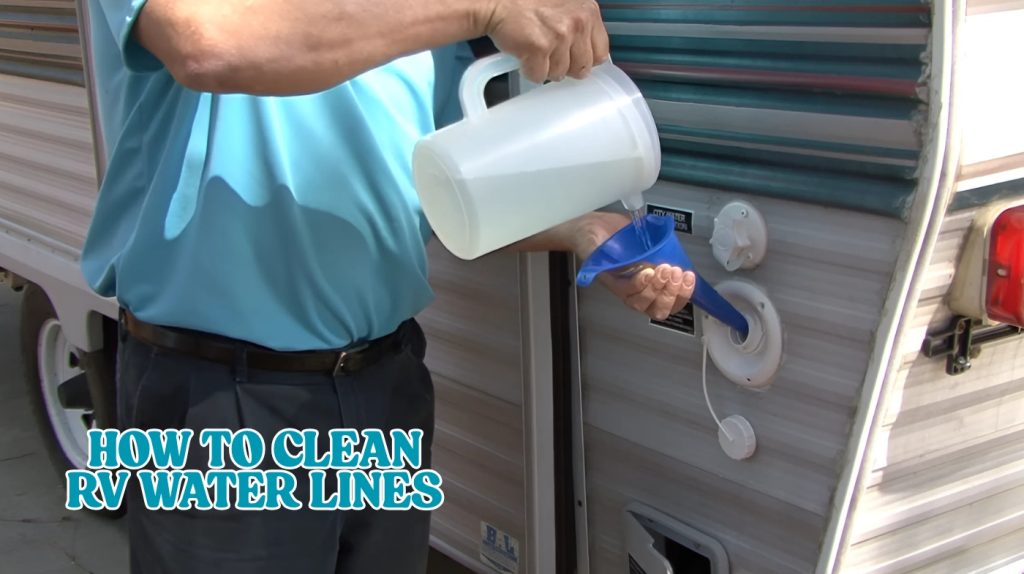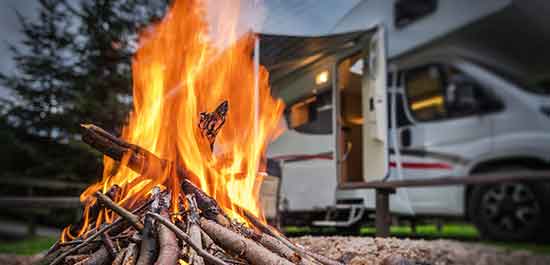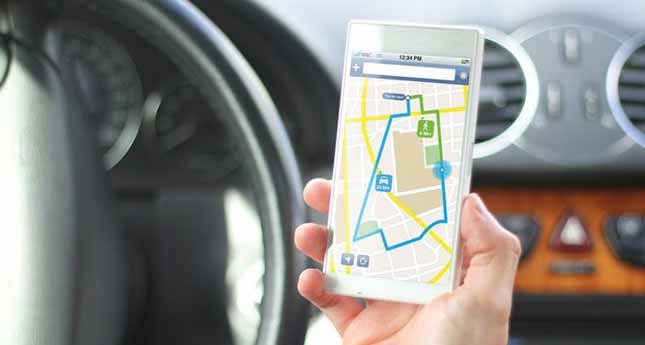Last Updated on June 25, 2025
To clean your RV water lines, first drain tanks, bypass the water heater, and shut off the pump. Mix bleach about ¼ cup per 15 gallons into the fresh water tank, then circulate it through all faucets and showers by running the pump.
Let the solution sit for several hours to disinfect. Next, drain completely and flush lines until the bleach smell fades. Proper upkeep and inspections help maintain water quality. Keep going to discover detailed steps and maintenance tips.
Key Takeaways
- Drain the fresh water tanks and bypass the water heater before sanitizing RV water lines to avoid bleach damage.
- Mix a bleach solution (1/4 cup bleach per 15 gallons water) and circulate it through the lines using the water pump and open faucets.
- Let the bleach solution soak in the water lines for at least 3–12 hours to effectively disinfect and kill bacteria.
- After soaking, flush the water lines thoroughly until no bleach smell remains, keeping drains open for continuous drainage.
- Regularly inspect and maintain water lines, valves, pumps, and filters, scheduling sanitization every six months or after storage.
Preparing Your RV Water System for Cleaning
Before you begin cleaning your RV water system, make sure to turn off the water heater and completely drain both the fresh water and hot water tanks. This prevents damage and removes old water and contaminants.
Sanitize the system at least once a year or when contamination is suspected to maintain water quality and safety. Using durable materials in your RV water lines can help reduce contamination risks.
Turn off the water heater and fully drain fresh and hot water tanks before cleaning your RV water system. Close the low-point drain valves once drained to prepare for refilling. Temporarily bypass the water heater and filter system to avoid bleach damage during cleaning.
Disconnect the city water hose to prevent backflow contamination and ensure no external water supply connects during the process. Turn off the water pump, then open and drain all faucets to release residual water and pressure. Inspect all connections for cleanliness before reattaching.
Use a funnel to add cleaning solutions to the tank filler carefully. These steps prepare your RV plumbing for effective sanitization and help prevent biofilm buildup.
Mixing and Adding the Bleach Sanitizing Solution
With your RV water system prepped and drained, you’re ready to mix the bleach sanitizing solution. Use 1/4 cup of household bleach (5% sodium hypochlorite) per 15 gallons of water for standard sanitizing. Using a properly filtered water source prior to sanitizing can help improve overall water quality.
For a 60-gallon tank, mix 1 to 1.5 cups of bleach with water in a separate container first never add bleach directly to the tank. This ensures even dilution and safety.
Adjust concentration if deeper disinfection is needed, referencing guidelines for 5000-20,000 ppm solutions. Once mixed, carefully pour the solution into your RV’s water tank.
Handle bleach with care to avoid skin contact and fumes. Short-term bleach use poses minimal risk of corrosion to the tank when used properly.
Proper mixing prevents damage to plumbing and ensures effective sanitization without corrosion risks. Next, prepare for circulating the solution through the system.
Circulating the Bleach Solution Through the Plumbing
Once you’ve added the bleach solution to your RV’s water tank, turn on the water pump and open every faucet and showerhead to circulate the solution through all plumbing lines. Keep faucets open until you see bleach-treated water at each outlet, confirming full system coverage.
This step is crucial as it prevents bacterial growth inside tanks and pipes, ensuring that your drinking water remains safe. Using an EPA-approved sanitizer can enhance the effectiveness of this process by killing harmful bacteria without leaving unpleasant residues.
Before circulating, engage the hot water heater bypass valve to prevent bleach damage to the heater’s interior. If your RV lacks a bypass, manually isolate the hot water heater per the manual’s instructions.
This circulation also sanitizes the fresh water hose if bleach was introduced at the hose connection. Using a 12V pump or drill-mounted pump can aid circulation when filling the tank.
Ensure the bleach flows only through cold and bypassed hot water lines for effective, safe sanitization. After completing the sanitization, it’s important to thoroughly flush the system to remove any residual bleach, maintaining safe water quality.
Letting the Sanitizer Work and Draining the System
After circulating the bleach solution, let it sit in the system for at least 5 hours to ensure thorough disinfection without damaging components. It is common to allow the solution to sit overnight for convenience, maximizing contact time for better sanitation.
You should then drain the solution completely, using faucets and low-point drains to remove all sanitizer from the plumbing.
Proper soaking time and full drainage are vital steps to maintain a clean and safe water system. For ongoing maintenance, it is recommended to apply quality sealants regularly to protect water lines from contamination and wear.
Soaking Time Importance
Although it might be tempting to rinse the system quickly, you need to let the sanitizer sit in your RV water lines for at least 3 hours to effectively kill bacteria and biofilms. Ideal soaking ranges from 4 to 12 hours, with overnight soaking ensuring thorough disinfection.
Shorter times won’t penetrate biofilms or reach all lines. Bleach oxidizes microbes during soaking without causing significant corrosion. Letting the sanitizer soak guarantees coverage to hidden crevices and less-used faucets.
It is important to bypass the hot water heater during sanitizing to prevent damage to the system. Using enzyme-based treatments can enhance the breakdown of organic material and improve sanitation effectiveness.
| Soak Time | Effectiveness |
|---|---|
| < 3 hours | Incomplete sanitizing |
| 3 – 4 hours | Bacteria reduced |
| 4 – 8 hours | Biofilms penetrated |
| 8 – 12 hours | Deep disinfection |
| Overnight (12+) | Maximum kill rate |
Proper System Drainage
Allowing the sanitizer to sit for the recommended time guarantees pathogens are neutralized, but you still need to properly drain the system to remove the disinfectant and any loosened debris.
First, turn off the main water supply, water heater, and pump. Open all faucets and low-point drain valves to allow air in and facilitate drainage. Regular draining every two weeks is important to prevent bacterial contamination in the water system.
Checking the water system pressure during this process ensures proper flow and drainage. Locate and slowly open the fresh water tank drain valve, directing water into a bucket or hose. Turn on the water pump briefly to push residual water out, keeping all faucets open.
Don’t forget to drain the water heater by opening its drain plug and pressure relief valve after shutting off power. Continue draining until flow slows to a trickle, then leave valves and faucets open to air out the system completely.
Flushing the Water Lines After Sanitization
Because sanitizing solutions need time to work effectively, you should wait at least 4 to 10 hours before flushing your RV water lines. Begin by running all faucets until the bleach smell disappears, keeping the gray water tank valve open to allow continuous drainage.
You may need multiple refill and flush cycles to fully clear sanitizer residue. Using a faucet with a 360-degree swivel spout can help ensure thorough flushing in all parts of the sink area. Drain and flush the water heater separately before flushing the lines.
Bypass water filters during flushing to avoid damage. It is important to thoroughly flush the system after sanitization to eliminate all bleach residue and ensure safe water quality.
| Step | Action | Notes |
|---|---|---|
| 1 | Wait 4-10 hours | Ensures sanitizer effectiveness |
| 2 | Open faucets individually | Flushes all lines thoroughly |
| 3 | Keep gray tank valve open | Allows continuous drainage |
| 4 | Flush water heater separately | Improves system cleanliness |
| 5 | Repeat flush cycles | Removes all sanitizer odor |
Maintenance Tips for Long-Term Water System Health
You should sanitize your RV water system regularly to prevent bacterial growth and maintain water quality. Use a bleach solution with the correct ratio of ¼ cup per 16 gallons to ensure effective sanitization without damaging components.
Inspect all components, including lines and connections, for damage or leaks each quarter to avoid costly repairs. Promptly address any issues to ensure long-term system health and reliable performance.
Additionally, considering energy efficiency in your RV’s systems can help reduce overall maintenance costs and improve sustainability.
Regular Sanitization Schedule
Although it may seem tedious, maintaining a regular sanitization schedule is essential for preserving your RV’s water system health. Sanitize your fresh water tank at least every six months if you use your RV full-time.
Also, sanitize after any storage period over a month or after de-winterizing to prevent microbial growth. Immediate sanitizing is necessary if water tastes or smells off. Using certified food-grade materials in your hoses helps maintain water safety throughout the system.
Many RV owners perform annual sanitization during spring or de-winterization as a common routine timing. Follow these key steps:
- Use a bleach solution (1/4 to 1/2 cup per 15 gallons) and run it through all faucets and shower heads.
- Let the solution sit for 12–24 hours to kill bacteria and algae effectively.
- Flush thoroughly with fresh water until no bleach smell remains, repeating if needed to avoid lingering taste.
Inspect and Repair Components
When maintaining your RV’s water system, regularly inspecting and repairing key components guarantees long-term functionality and safety. Check the water pump for consistent pressure and unusual noises; service it per manufacturer guidelines.
Many pumps feature thermal protection to prevent damage during dry running, enhancing durability. The fresh water system supplies water for cooking, drinking, and bathing, so its proper maintenance is essential.
Test the pressure regulator to maintain ideal flow and prevent damage. Inspect all water lines and hoses for cracks or wear, ensuring connections are tight and replacing compromised hoses immediately.
Examine valves and faucets for leaks, smooth operation, and mineral buildup, lubricating or replacing parts as needed. Monitor water filters, cleaning or replacing them on schedule to preserve water quality and prevent contaminants from entering the system.
Routinely inspect for leaks around fittings and fixtures; shut off water immediately if found. Repair or replace faulty components, then test under pressure to confirm system integrity and prevent future issues.
Frequently Asked Questions
Can I Use Alternative Sanitizers Instead of Bleach for RV Water Lines?
Yes, you can use alternative sanitizers instead of bleach for RV water lines. Options like chlorine dioxide, iodophor, Starsan, and food-grade hydrogen peroxide effectively disinfect without bleach’s odor or harshness.
Natural choices such as white vinegar, grapefruit seed extract, or citric acid also work but may need longer contact times or heat. Always follow product instructions carefully to avoid plumbing damage and guarantee thorough sanitation.
How Often Should I Clean and Sanitize My RV Water System?
You should sanitize your RV water system at least twice a year if you use it full-time. For occasional or seasonal use, sanitize before each trip, especially after storage over 2-4 weeks. Increase frequency if you notice unusual taste or odor, or after filling from uncertain sources.
Larger groups, longer trips, and boondocking require more frequent cleaning every 2-4 weeks is ideal to prevent bacterial buildup and maintain system health.
What Should I Do if My RV Water Tastes Like Bleach After Cleaning?
Imagine running water through your RV faucets, tasting bleach unexpectedly that’s residual sanitizer. To fix this, flush all faucets (hot and cold) until the taste fades. Drain and refill your fresh water tank several times, flushing thoroughly each cycle.
Always use the correct bleach dilution and bypass the water heater during sanitizing. If bleach taste lingers, consider inline filters or professional cleaning to protect your system’s integrity and water quality.
Is It Safe to Drink Water Immediately After Flushing the System?
You shouldn’t drink water immediately after flushing the system. Even if you’ve flushed thoroughly, residual bleach or sanitizing agents can remain. Wait until the bleach smell completely disappears and the water tastes normal before using it for drinking or cooking.
Make certain you flush all faucets, including hot and cold lines, multiple times. This prevents toxin ingestion and protects your health. Always confirm complete removal of chemicals before consuming the water.
How Do I Prevent Biofilm Buildup in RV Water Lines Between Cleanings?
Think of your RV water lines as a garden where bacteria try to grow weeds biofilm. To keep your garden clean, don’t let water sit stagnant; flush lines regularly and avoid filling tanks completely.
Use EPA-approved sanitizers like chlorine dioxide or hydrogen peroxide to disrupt growth. Running water often and monitoring quality acts like daily watering and weeding, preventing those unwanted colonies from taking root between cleanings.
Keep It Clean: Maintain Your RV Water System Like a Pro
Now that you’ve cleaned your RV water lines, don’t rush to fill the tanks just yet. There’s one essential step left that guarantees safety and taste flushing out every trace of bleach thoroughly.
Skip this, and you might face unpleasant surprises on the road. Follow the flushing instructions carefully, and maintain your system regularly. Your clean water lines will then deliver fresh, safe water every time you hit the road.



